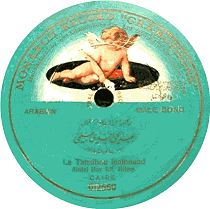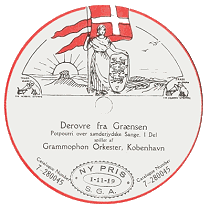Recording
Locations
The
first recordings of the Gramophone Company
were made in London, probably on Monday,
August 8, 1898. The first recordings
outside of London were made on the so-called
Six Cities tour beginning in Leipzig
in May 1899, and continuing on to Budapest,
Vienna, Milan, Paris, and Madrid. A
Branch Office was established in each
of these cities. The recordings were
all made on wax-coated zinc plates,
and are Berliners with no paper labels.
The recording location was usually embossed
at the bottom of the central area. When
paper labels were introduced in January
1901, the recording location was printed
just above the catalog number. The images
below show labels from the majority
of European recording locations.
Recording locations do not come from
ledgers but from the Weekly Return Sheet
sent every week to Hanover by each expert.
The sheets are headed:
Return
of Records made by....................
at...................
for
the Week Ending.......................
The amount of detail seems to depend
partly on the Branch and the clerk but
the first column lists the serial number,
the second the indicating letter, the
third the recording date (sometimes
omitted), the fourth (and largest) gives
the title and the fifth (not very big)
gives the artistes.
Alan
Kelly affirms that the city indicated
on the record label is not necessarily
that of the recording location. Artists
were frequently asked to come to a central
recording location where the local recording
expert had set up shop, but the label
indicated the city from which the artists
had come and where, presumably, the
records were most likely to be sold.
It was often repeated that it was cheaper
to bring the artists to the studio than
to take the expert and his equipment
to the artists, and occasionally an
entire group from, say, Amsterdam, would
be recorded in Paris; the label would
then specify "Amsterdam" [or
even "Brussels"!]. Of course,
when recording an artist like Paderewski
the expert could make a special trip.
In any case, there would be no problem
in recording visiting artists who happened
to be in Berlin while a session was
in progress (courtesy of Alan Kelly).
In addition to the labels shown below,
other recording locations used before
February 1908 in Germany included Ansbach,
Beyreuth, Cologne, Frankfurt, Karlsruhe,
Königsberg, Leipzig, Stuttgart,
and Wiesbaden. Austrian locations included
Graz and Salzburg, while in Czechoslovakia
the sole recording site was Prague,
and in Switzerland at Zürich. Recordings
were made also in Amsterdam, Belgrade,
Budapest, Bucarest, the Hague, Helsinki
(then Helsingfors), Kristiania, Lisbon,
Lwow, Poltava, and Sofia, as well as
in Algiers, Baku, Bombay, Colombo, Corea
(Korea), Delhi, Hyderabad, Lahore, Lucknow,
Madras, Osaka, Rangoon, Tiflis, Tokyo,
and Tunis in Africa and in the Far East.
Additional locations were added following
the introduction of the Dog trademark.
Whether or not the recording locations
were identified on the issued discs
is unknown at this time. One may note
that all recordings in Italy were made
in Milan, with the single exception
of the Tamagno recordings made at his
villa in Ospadeletti in February 1903.
In France the sole recording location
appears to have been Paris.
|
|
|
|
G&T
Angel trademark
French, 1905
|
Riga
pressing Leonid Sobinov
Moscow
February-March 1904
|
Following
the establishment of the manufacturing
plant in Ivry outside of Paris, all
recordings made in Barcelona, Madrid,
Brussels and Paris were sent there to
be processed. When the plant in Barcelona
was established in 1908, the Spanish
recordings were sent there. By that
time the original G&T label had
been discarded and replaced by the so-called
pre-DOG, identified by the company designation
of The Gramophone Company, Ltd, in various
languages. At the same time the plant
in Sealdah near Calcutta, India, was
prepared to receive all recordings made
in the Far East.

The G&T label of the Gramophone
& Typewriter Ltd was used on all
paper labels on records issued between
December 10, 1900 and November 18, 1907,
from both the Hanover and the Riga plants.
From November 19, 1907 to February 1909,
records processed at these plants were
issued with the so-called pre-DOG label,
in English, Russian, or other appropriate
language.

Cairo,
October 1906
|
|
|
|
Amsterdam
January 12, 1905
|
Berlin,
7-inch
late 1902
|
The
first Gramophone Company recordings
in the Netherlands were made in The
Hague by William Sinkler Darby during
his second European tour. These 97 recordings
were all made in January 1900 on 7-inch
wax-coated zinc plate and were thus
Berliners; all had the suffix A,
to distinguish them from Fred Gaisberg’s
unlettered series.
|
|
|
|
Pre-DOG
September 1907
|
Copenhagen pre-DOG
September 1908
|

Copenhagen,
February 6, 1919
|
|
|
recorded
in late October 1904
|
The
spelling of Constantinople on the labels
above indicates that these pressings
were made at the Hanover plant. The
two discs below were manufactured in
the Dum Dum plant outside of Calcutta.
|
|
|
|
|
|
|
Berlin,
February 20, 1914
|
Dresden,
Feb-Mar 1902
|
|
|
|
|
G&T,
June-July 1904
|
|
|
|
|
Breslau
pre-DOG, 1908
|
Dresden
HMV Concert, June 24, 1905
|
|
|
|
|
Dresden,
late 1907
|
Dresden
pre-DOG, 1908
|
|
|
|
|
|
Hamburg
pre-DOG, 1908
|
|
|
|
|
Kristiania,
September 25, 1908 London
|
|
|
|
|
|
G&T
February 8, 1907 London
|
HMV.
August 21, 1906
|
|
|
|
|
HMV
Monarch, Jul-Aug 1908 London
|
HMV
Concert, July 1908
|
|
|
|
|
London
HMV Monarch, July 20, 1909
|
Milan
pre-DOG 1906
|
|
|
|
|
G&T
July 1901 Milan
|
G&T,
November 1906
|
|
|
|
|
Moscow,
1904
|
Munich,
1902 7-inch
|
|
|
|
|
Munich,
August 1906
|
Paris,
1902
|
|
|
|
|
Paris
HMV Concert 1904
|
HMV
Monarch April 1904
|
|
|
|
|
|
Paris,
April 12, 1927
|
The label at the right above carries
the legend "Disque Fabriqué
par la Cie Française de ▬▬▬▬
Gramophone, Nogent s/M. Seine, France"
below the outer ring. This electrically
recorded issue indicates that a pressing
plant was present in Nogent-sur-Marne,
some 6.7 miles to the northeast of Paris,
by the year 1927. The 1907 plant opened
at Ivry was some 6 kilometers southwest
of the Notre Dame cathedral, just outside
of Paris.
|
April
1902
|
Rome
|
April
1904
|
|
|
|
|
Rome,
April 1904
|
St.
Petersburg, January 1904
|
|
|
|
|
St.
Petersburg, pre-DOG 1908
|
Stockholm, pre-DOG February
1907
|
|
|
|
|
October
18, 1911
|
August 1913
|
|
Stockholm
|
|
|
|
|
Syria
c. 1907
|
Vienna,
7-inch, May 1902
|
|
|
|
|
June
1907
|
pre-DOG
1908
|
|
Vienna
|
|
|
|
|
Leo
Slezak, Vienna 1905
|
Warsaw
1902
|
|
|
|
|
Wilna,
late 1903
|
|
|
|
|
Weimar
early 1905
|
|
Epilogue
Men
such as Fred W. Gaisberg, W. Sinkler
Darby and others found themselves travelling
the world in search of music to record.
These pioneers were more than just recording
engineers. They were required to find
suitable artists, haggle over fees,
make artistic and administrative decisions
and only then actually conduct recording
sessions. The companies relied upon
their judgment absolutely and in most
cases it was surprisingly sound. Listening
today to pre-1914 Egyptian, Indian or
Indonesian recordings, one is often
aware of a purity of style and a consistently
high quality of musicianship. As much
as any other one factor, this is probably
due to the lack of media-generated cross-cultural
influence that we take for granted today.
Also, there is historical evidence that
most of these engineers coupled some
degree of formal musical training with
an ability to gauge potential appeal
even if they disliked the style ─
for example, in Fred W. Gaisberg's Shanghai
diary for March 18th 1903 we find the
following entry;
"We
made our first records. About fifteen
Chinamen had come, including the accompanying
band. As a Chinaman yells at the top
of his power when he sings, he can
only sing two songs an evening and
then his throat becomes hoarse. Their
idea of music is a tremendous clash
and bang; with the assistance of a
drum, three pairs of huge gongs, a
pair of slappers, a sort of banjo,
some reed instruments which sounded
like bagpipes, and the yelling of
the singer their so-called music was
recorded on the gramophone."
"On
the first day, after making ten records
we had to stop. The din had so paralysed
my wits that I could not think."
A
classic example of culture-shock! Gaisberg
however, despite his attitude, put commercial
consideration before personal taste
or prejudice. He recorded, among other
things, street songs, 'Moon Guitar'
solos and traditional Chinese opera
– and he was the first to do so.
It
is arguable that the first gramophones
captured the public imagination world-wide.
Lured by the carrot of enormous profits,
the fledgling industry penetrated almost
every country and, in doing so, preserved
a huge and varied body of indigenous
music at a key period in history. Key
for two reasons. The First World War
and its political and social ramifications
were soon to alter the world map irrevocably,
sweeping away much language, culture
and social structure that had existed
for centuries. The gramophone itself,
by its very success, was also to alter
the pattern of localised musics into
other cultures. West Africa, for example,
was first exposed not solely to the
popular music of America and Britain,
but also to that of India.
The
Indian continent, colonised as it then
was, had readily absorbed the new technology
as early as 1900. Within five years
a considerable catalogue of Indian music
was being enthusiastically consumed.
Significantly, Indian traders who operated
throughout Africa often successfully
offered their own musical taste to their
new customers.
By
the '20s, separate African markets had
been established, principally by The
Gramophone Company, Odeon, Pathé
and later Decca, to sell what was uniformly
referred to as 'Native Music'. However,
these new African records often displayed
elements of a syncretic rather than
a traditional approach and a factor
in this was the cross-fertilising influence
of the gramophone itself. Throughout
the ''30s and '40s the widespread sale
of HMV's Cuban and Latin-American 'GV'
series was to exert further influence
on the development of West African music.
This historically important catalogue
introduced the music of the Sexteto
Habanero, Don Azpiazu, Trio Matamoros
and others to a rising generation of
African musicians who absorbed and remodeled
it within their own environment.
Despite
publicity to the contrary, the record
companies often had little idea of the
historical or contextual importance
of their activities. All they really
cared about was continued and expanding
sales. In this way they unwittingly
captured for future generations seminal
- and often unexpurgated - examples
of the Tango, Rebetika, Fado, Jota Rhumba
Son, Qassida, Tzigane and Beguine. They
also recorded traditional Nigerian wrestling
ballads, Maori choirs, Sardinian piping,
Maltese ballads, Basque choral music
and a host of other material that, in
retrospect, is of vast historical importance.
The
countries that represented the 'First
World' in forms of technology at least
during this period, were principally
America, Britain, France, Germany, India
and Spain. There were no mastering or
manufacturing facilities in the whole
of the African continent. Greece, Italy,
Portugal and many other countries then
starved of technology rolled upon mainly
British, French or German support for
the recording, manufacture and supply
of music. Recording sessions would routinely
be conducted on location by visiting
engineers who took the masters back
with them for process and manufacture.
The finished product, label, sleeve
and all would then be ‘exported’ to
the country of origin ready for sale.
During
the half-century prior to World War
Two the commercial record companies
preserved a staggering quantity of indigenous
music by the simple expedient of recording
almost anything that came their way.
The recovery, preservation and appreciation
of this rich heritage is both historically
important and immensely enjoyable. Now
that specialist record companies are
making well-researched and lovingly
crafted reissues available, their work
deserves the awareness and support of
all who wish to understand and appreciate
the historical underpinnings of current
World Music.